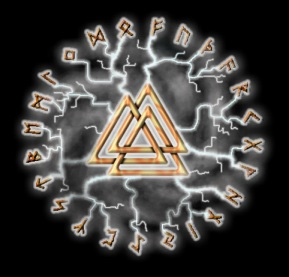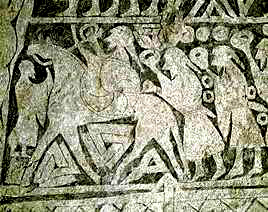The valknut "THE KNOT OF DEATH"
THE KNOT OF DEATH / THE NINE WORLDS /GERMAN PAGAN LINKS / RUNES / MEANING OF THE RUNES
THE IRMINSUL / THE YGGDRASIL / THE EXTERNSTEINE / THE HISTORY OF HALLOWEEN

The Valknut or "folk knot" is an Old Norse symbol consisting of three interlocking triangles, also known as "the knot of death" and "knot of the slain." The name Valknut is an unattested modern invention used to describe the symbol, and was not used originally. From the 4th century onwards the Norse people carved symbols known as runes on stone and wood. The Valknut is a rune which represents the slain and is a triangular version of the Borromean Rings. It has been compared to the three-horned symbol found on the Snoldelev Stone from the 19th century and may be related to it. It is best found on stone carvings and funerary steles where it signifies the afterlife, the placement of the symbol on funeral monuments mark it as a sign of reincarnation. It can also be found in use as a protective charm, as on a bedpost found in the Oseburg Viking Ship. There are 2 kinds of Valknut, the unicursal, which is one continuous ribbon knotted upon itself as seen on the 7th century Tangelgarda stone and the triple version, which is made by three separate triangles that appear in "brunnian linked" form as on the Larbro stone as well as upon a ring found in the River Nene in England.
The nine points and three interlocking shapes are known to represent rebirth, pregnancy and the cycle of reincarnation. They are also known for the nine worlds or nine fates of Norse mythology, and also have an obvious correlation with childbirth. The number 3 is a very common magic symbol in Norse paganism. Three multipled by three represents the nine worlds which are united by the Yggdrasil tree. The interwoven shape also suggests the three realms of earth, heavan, hel and it's encompassing nine domains. It was probably meant to be a powerful talisman in many cultures and religions as the number nine has significance in Norse myths. In neo pagan faiths the The Valknut plays a major role drawn from Norse mythology, particularly Asataru, where it also represents the nine worlds and signifies the universe.
The Valknut is also seen as a bind rune and is thought to symbolize the power of the god Odin. The symbol resembles triangles emphasizing the meaning of wyrd. The term "wyrd" is used to denote death rather than an unfolding future. It's clear that there are only two things gods cannot avoid, fate and death, and death is the fate of every being. Wyrd means nothing less than the moment of death and the moments leading up to it.
There are several other theories surrounding the Valknut:
1. Hrugnir's Heart
Chapter 17 of the 13th century Prose Edda book Skaldskaparmal has a description of the heart of the Jotunn Hrungnir.
Hrugner had a heart that was made of stone with three sharp pointed corners.
The Valknut is thought to symbolize the power of Odin to bind and unbind a man's mind in order to render him helpless in battle. He could also loosen the tension of fears and madness.
3. Other
The fact that the Valknut Appears on picture stones with Oden signifies it's religious practices surrounding death.
tangelgarda Stone
Odin with Sleipnir, Valknuts are drawn beneath the horse (Tängelgarda stone)

the stora hammar stone
The Stora Hammar stone, where the Valknut occurs in the most central and predominant position, appears alongside images interpreted as Odin with a characteristic spearshunting another figure into a burial mound while a raven is overhead and another man is hanged.

Oseberg Ship
The bedpost shown below is one of the objects found on the Oseberg ship - the grave of a prominent woman, possibly a queen, who died in 834. The ship, dating from around 815-820, was uncovered in 1904 when a burial mound on the west coast of the Oslo Fjord was excavated. Before being buried, it had been used for many years as a sailing vessel, probably as a royal pleasure craft. The ship and its contents are now in the Viking Ships Museum in Oslo.
The picture is taken from: David. M. Wilson and Ole Klindt-Jensen, Viking Art, George Allen and Unwin Ltd, 1966. The enlargement shows the walknot in the upper left in more detail.

